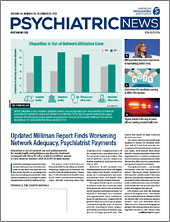Product developers, investors, administrators, and regulators in health care gathered in Las Vegas in October for the second annual HLTH conference. The health innovation conference combines engaging educational panels, product demonstrations, and networking sessions into one supercharged event aimed at improving and—if need be—disrupting health care.
Though the conference focused on enhancing all fields of medicine, using technology to enhance mental health care was the focus of several sessions. Topics that generated buzz included new approaches to workplace mental health programs (driven by an increased appreciation of mental health by millennial employees), the use of virtual and/or augmented reality devices to improve memory and well-being in seniors, and the risks and benefits of using artificial intelligence to scan through patient records.
Two innovations with the potential to change how mental health care is delivered particularly stood out: telemedicine and digital therapeutics.
How Will Telehealth Transform Care?
In 2012, many in health and technology felt that advancements in video technology combined with growing interest in integrated, patient-centered care would lead to major growth in telehealth. Although telehealth has advanced over the years, it has not yet become as transformative in medicine as those analysts had anticipated, Kevin Pereau, CEO of consulting firm TranscendIT Health, said during a session he moderated on the future of telehealth. There are signs, however, that telehealth remains of interest to the industry, Pereau said. For instance, Amazon launched a pilot health program for its Seattle employees called Amazon Care that relies heavily on video- and chat-based care. He and the panel discussed whether such interest is likely to continue to grow or fizzle in coming years.
Ann Mond Johnson, CEO of the American Telemedicine Association, had an optimistic outlook on the future of telehealth. “We have seen many positive tailwinds recently,” she said. “The price of technology keeps going down, federal reimbursement [for telehealth] is getting better, and large organizations like the VA are actively looking to improve telehealth access to their members.”
Importantly, numerous clinical studies over the past decade, especially in telepsychiatry, have shown that virtually delivered therapies (like cognitive-behavioral therapy) are as effective or sometimes superior to in-person treatment, she continued. “The myth of telehealth as a second-class medicine is finally going away.”
Looking ahead, the panelists agreed that states need to update their medical licensure laws to enable physicians and other health care professionals more freedom to provide telehealth services across state lines. Johnson noted that the AMA has been a strong advocate for so-called “open sky” laws, but change has been slow. According to a recent report from the Center for Connected Health Policy, medical boards in nine states have provisions for special licenses related to telemedicine practice; physicians need to do the work of obtaining a regular license in any other state they may practice remotely. Twenty-nine states have agreed to participate in an interstate compact aimed at streamlining the licensure process for physicians seeking licenses in multiple states (though the implementation has not been finalized in a few of these states).
Studies have also shown that while telehealth may be attracting patients who already access traditional health services (supplementing in-person appointments), the technology has yet to engage patients who do not use traditional health services, said Fay Rotenberg. Rotenberg is president of Firefly Health, a digital concierge platform that connects patients with primary and behavioral care providers. For example, a survey by the marketing firm JD Power found that two-thirds of those surveyed who reported not using telehealth said telehealth was not available as part of their health plan or they were not aware whether it was available; people in rural areas reported the least access to telehealth.
“Telehealth can definitely improve access to care, but it may also heighten existing disparities if we are not careful,” cautioned Peter Fleischut, M.D., the chief transformation officer at New York-Presbyterian Hospital, who oversees the management of electronic health records, telehealth, and other digital services. He said that hospitals or other health care centers need to ensure that telehealth is not solely used to replace in-person patient visits.
Telehealth done properly will connect not only patients to doctors, but also specialists to nonspecialists. For instance, mental health centers can use non-psychiatrist behavioral health coaches as a primary point of contact with patients, with occasional video consultation from a psychiatrist when necessary. Such practice can amplify care by optimizing the psychiatrist’s time.
As to when telehealth might finally change health care delivery, Fleischut suggested thinking of vocabulary instead of time. “The day we stop calling it telehealth and just refer to it as health care, we’ll know that we made it.”
Excitement Over Digital Therapeutics Builds
Digital therapeutics—roughly defined as a medical intervention that employs software as a central aspect of treatment—are also poised to change health care delivery, predicted speakers at another HLTH panel.
“Two-thirds of people with mental illness don’t get adequate care,” said Acacia Parks, Ph.D., the chief scientist of Happify Health, a mobile app company working on a digital therapeutic for major depression associated with multiple sclerosis. “A digital therapy can be used right in the house, so it’s appealing to patients who can’t or don’t want to seek in-person care,” she said. “The patients can also use it whenever needed and don’t have to wait a week or month until their next appointment.”
Though a digital therapeutic can take many forms, one popular variant in mental health care is the video game–based treatment.
“There are two big reasons why ‘gamifying’ is a popular approach,” said Matt Omernick, the chief creative officer for Akili Interactive, a company currently conducting clinical studies with a cognition-stimulating video game for children with attention-deficit/hyperactivity disorder. “Games can be readily adapted to match a patient’s cognitive skill level and they keep people engaged.”
“I say this somewhat tongue in cheek, but the blockbuster drug of this era is the engaged patient,” added Anand Iyer, Ph.D., the chief strategy officer for Welldoc, a company which produced Bluestar, an FDA-approved digital assistant that helps patients with type 2 diabetes maintain their blood sugar levels. Regardless of their disorder, getting patients to adhere to their treatments and related lifestyle changes is a fundamental issue, he noted.
“Another advantage of digital-based treatments is that we can put safety guardrails directly in the products,” said Parks. She noted that clinical trials for drugs include many provisions that monitor patients closely and ensure safety, but once a drug is approved and out in the real world, these rigorous controls are no longer present. A therapeutic game, though, could easily be designed with an automatic shut off to ensure people don’t play in excess, as one example.
Digital therapeutic designers cannot forget about the doctors, though, Iyer continued. “Before you think about how you scale up your product or whether it should be prescription based, think about how well the product integrates into a physician’s workflow,” he said. “No matter how exciting it looks, if a product adds unnecessary work, a physician won’t adopt it.”
As more digital products seek regulatory approval, the biggest short-term question in this field is how efficacy is measured, the panelists said. “These games or apps act like medication, so we are concerned about placebo effects,” Parks said. “But what is a good placebo for technology? I’m not sure if we know that answer yet.”
Currently, digital therapeutics also exist as a regulatory hybrid; they are designed like medications with specific dosing instructions (for example, play 20 minutes a day), but they go through similar FDA clearance process as a medical device. Parks said this reflects the uncertainty over where these new products fit in health care, and working out a better approval pathway remains a key short-term goal.
She was hesitant to make long-term predictions, though, other than that digital therapies will look much different in 20 years. “I think it will be similar to the music revolution,” she told the audience. “It started small, with the ability to buy individual songs and put them on your iPod. Today, you don’t even buy music anymore, you just subscribe to a service that provides whole music libraries on any device you want.” ■
The Center for Connected Health Policy report “State Telehealth Laws and Reimbursement Policies” is posted
here.


